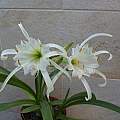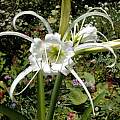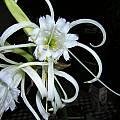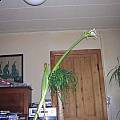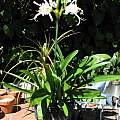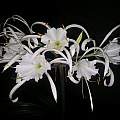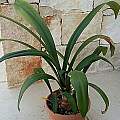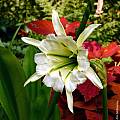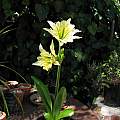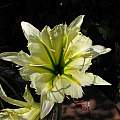Plants pictured on this page are hybrids of the Hymenocallis complex which includes Hymenocallis, Ismene, Elisena, and Leptochiton.
The hybrids listed below are commonly grown and are sold both as Hymenocallis and as Ismene. If you support the Ismene split by Meerow in 1990 they would be Ismene hybrids since they are crosses of species now included in Ismene.
Cultivation of these hybrids is similar and not difficult. In the cool and mild climate of the San Francisco Bay Area, they go dormant in the winter and break dormancy in mid May. The plants will continue growing leaves and will start blooming in mid August. The plants seem to like a rich, but well drained mix. It is better to grow them in plastic pots since it keeps the soil from drying out too quickly. I give them water every few days and a dash of time release fertilizer at the beginning of the growing season. The soil must be kept moist or the flowers will abort in drought conditions. I have not observed any fungal diseases associated with my plants.
Ismene 'Advance' (syn. Hymenocallis 'Advance') is a hybrid of Ismene 'Festalis' backcrossed to Ismene narcissiflora. Photo taken July 2009 by Jay Yourch.
Ismene 'Excelsior' is a hybrid between Hymenocallis traubii and Ismene narcissiflora (syn. H. narcissiflora). It looks like a bigger version of Hymenocallis traubii (syn. Hymenocallis tridentata) and needs plenty of water during emergence of bud, otherwise it will abort. Photo by Angelo Porcelli
Ismene × festalis (syn. Hymenocallis × festalis) or sometimes referred to as Ismene 'Festalis' is a garden hybrid between Hymenocallis longipetala (syn. Elisena longipetala, syn. Ismene longipetala) and Hymenocallis narcissiflora (syn. Ismene narcissiflora). The flowers are large and scented with a spicy aroma.
Although I grow my plants in pots, many others either have seen or have grown the plants in the ground where the bulbs offset quite easily. They do marvelously in the ground in certain places (central Argentina with warm climate) as reported by Alberto Castillo. During winter dormancy, they receive no rain (contrary to the Bay Area where they get lots of winter water). The plants described by Alberto have been in the ground for many years and bloom prolifically without the necessity of division.
In colder climates where freezing occurs, the bulbs should be dug up before frost (with as much roots attached as possible) and allowed to dry in the open air. Once dried, the soil is removed and the bare bulbs/roots are allowed to dry for several weeks. Once dried, the bulbs are stored in plastic bags. It is important that the roots remain plump and pliable during this drying process. As with any amaryllid, massive damage to roots will prevent blooming the following year. When warm weather returns, the bulbs are planted in the ground. This treatment works very well for Jim McKenney in his cold Maryland, USA climate. Jim also mentioned that it is possible to grow them where he lives right next to a wall of the house without digging them up in the winter. However, the plants are not quite as vigorous and do not bloom as reliably.
Photo #1 was taken by Sheila Burrow. Photos #2-3 were taken by Carol Jensen. Photo #4 was taken by Nhu Nguyen showing the habit of the plants in a pot.
Ismene x macrostephana (syn. Hymenocallis × macrostephana) is a hybrid between Hymenocallis speciosa and H. narcissiflora (syn. Ismene narcissiflora), the Peruvian Daffodil. It was made by Van Tubergen in the late 19th century and named Daphne. It has very large flowers, as the name implies (big crowned), which are sweetly scented and last a bit more than other species. It flowers in late summer, when the new wide leaves appear. Plants are frost sensitive needing a minimum temperatures of +5 °C (41 °F). Photos by Angelo Porcelli.
Ismene 'Sulphur Queen' (syn. Hymenocallis × spofforthiae 'Sulphur Queen') is a hybrid between H. narcissiflora (syn. Ismene narcissiflora), the Peruvian Daffodil, and Hymenocallis amancaes, (syn. Ismene amancaes) a yellow-flowered Peruvian species. The yellow color of 'Sulphur Queen' is fleeting, whether due to heat or bright light I'm not sure. This elegant, easily-grown plant is sweetly fragrant with a hint of spice. Photo #1 by Jim McKenney of a plant growing in his garden. Photos #2-3 were taken by Nhu Nguyen. The color remained very nice and yellow until senescence in his mild climate.
Other related links are: Hymenocallis - Ismene

